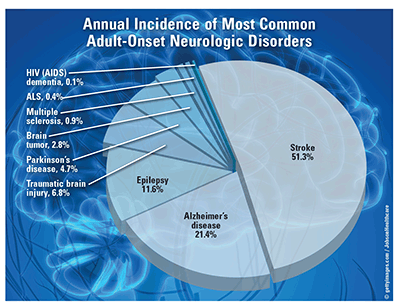US Pharm. 2018;43(1):24.
Twenty million Americans experience some form of neuropathy, and 16% of U.S. households contain an individual with brain impairment. According to the Federal Interagency Forum on Aging-Related Statistics, 35.8% of persons aged 85 years and older have moderate or severe memory impairment.

Prevalence and Incidence: One hundred million persons have chronic pain, 70 million people experience sleep/wakefulness problems, and 69 million individuals have vestibular and balance disorders; altogether, these cases constitute 54% of occurrences of the top 10 neurologic diseases. Hearing impairment affects 48 million individuals, or 20% of Americans. The prevalence of migraines is 28 million. Chronic tinnitus, substance-abuse disorders, blindness, and visual impairment affect 20 million adults each. Annually, of the 1.2 million most frequently diagnosed adult-onset brain disorders, 51.3% and 21% are due to stroke and Alzheimer’s disease, respectively. Each year, the total number of new episodes of Parkinson’s disease and traumatic brain injury equals the total number of epilepsy episodes (135 million). Nearly 500,000 cases of brain tumor, multiple sclerosis, and amyotrophic lateral sclerosis are diagnosed each year.
Hearing Impairment: Hearing loss is the third most prevalent health problem in older adults, following arthritis and heart disease. Fifty million Americans experience tinnitus, and 90% of those individuals also have hearing loss. More than 30 million Americans are exposed to dangerous levels of noise in the workplace, according to the Hearing Loss Association of America. There are 48 million Americans who have significant hearing loss, and 80% of people with hearing loss who could benefit from a hearing aid do not wear one. Fewer than 30% of persons aged 70 years and older who could benefit from hearing aids actually use them, and the number drops to 16% for adults aged 20 to 69 years. At age 65 years, one in three people has hearing loss, and 60% of people with hearing loss are either in the workforce or in educational settings.
Migraine and Other Headaches: A vast majority (90%) of the population suffers from headaches at some point. The prevalence of chronic daily headache is 4%, and 3% of all migraineurs experience chronic migraine. A 2014 study found that more than 80% of patients with self-diagnosed “sinus headaches” actually had migraines, and females were more likely than males to have experienced a migraine or severe headache (21.8% vs. 10%). In 2008, migraine-related headaches were the first-listed diagnosis for more than 3 million emergency room visits.
To comment on this article, contact rdavidson@uspharmacist.com.






